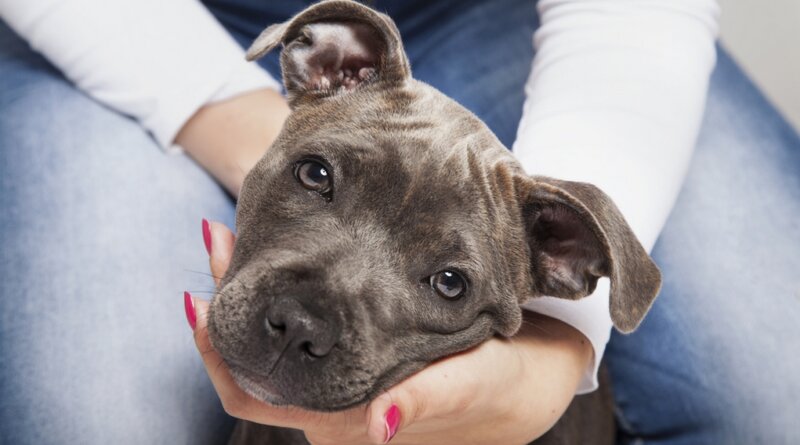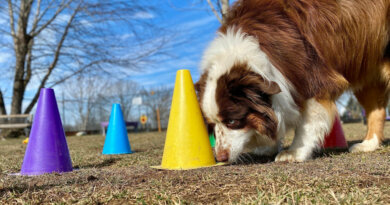Vet’s Tips on How to Raise a Pit Bull Puppy Healthily
Whether you’re adopting or purchasing a new Pit bull, do the research. Many reputable breeders pride themselves on breeding puppies with excellent health and temperaments.
But the opposite is often found, with so-called breeders just looking to make a quick buck.
Choosing a healthy and well bred puppy is the first step in learning how to raise a Pit Bull puppy healthily.
In my years of practice as a veterinarian, I’ve seen way too many cases of health problems in Pit Bulls that could’ve been prevented if the owners knew better.
This particularly applies to puppies and knowing how to raise a Pit Bull puppy the right way.
Where do you start?
When rescuing from an animal shelter or dog rescue center, you likely won’t have access to much information about the Pit Bull puppy. It’s up to you to ask the center lots of questions, which you absolutely should do. They may well know who the breeder is and whether littermates have suffered from any medical complications.
In this article, I’ll give you a brief on what you need to know about adopting a Pit Bull puppy. Note that after you first take your Pit Bull puppy home, it’ll be a time consuming experience. You will need the patience of a saint. Be sure to switch him over to a new food slowly as diarrhea can quickly lead to dehydration with puppies, which can be deadly.

Despite all the stereotypes about them, Pit Bulls are a fantastic breed and can really make a house a home. As a vet, most of the Pit Bull breeds I’ve met were wonderful, calm and obedient dogs. But to raise a Pit Bull, an owner needs a lot of dedication and know-how.
As most Pit Bull owners will confirm, once you’ve met a well brought up Pit Bull dog, you’ll likely be sold on the breed. But if you’re still on the fence, why not get in touch with a local breeder? Let them know your concerns, and ask whether you might be able to pop over and meet their dogs and find out more about their experience with the breed.
RELATED: Pit Bull Muscle Gaining 101 – How to Bulk Up a Pit Bull Healthfully
With that said, here’s what you need to know about how to raise a Pit Bull puppy well.
How to Raise a Pit Bull Puppy Healthily
The Pit Bull Breed
The name Pit Bull actually encompasses several dog breeds of a distinct type, including:
- American Pit Bull Terrier
- American Staffordshire Terrier
- American Bully
- Staffordshire Bull Terrier
Many people have the misconception that Pit Bulls are vicious beasts with courts of law calling them a “public health hazard.” However, a recent study shows that, in fact, the exact opposite is true and technically, Pit Bulls are less aggressive than Chihuahuas.
Pit Bulls are one of the most loyal breeds of dog. When raised properly and socialized from a young age – they will make the best pet that you could possibly wish for. The key is to not judge a dog by the looks, because according to science, it’s not always possible to tell if a dog will be truly aggressive or not based on the breed alone.
Choosing Your Pit Bull Puppy
Learning how to raise a Pit Bull puppy healthily starts before you even bring your new friend home. Get the priorities straight – be sure that you have the time, money, and patience that is required for raising a dog.
Much the same as having children, a new puppy will bring sleepless nights, expenses, and take up a lot of your time. Having said that, if you’re up for the challenge – the rewards that come along are beyond worth it.
Adopting from animal shelter or breeder
Rescuing a puppy from your local animal shelter or dog rescue is the best option, but other ways to adopt a dog are available too. When working with animal shelters, not only will you be doing your bit of good, but you may also have access to additional support, training help and any other aid offered by the animal organization.
If you’re not sure that you have the resources to take on a pup without all of the background information, then you may want to consider purchasing a puppy from a reputable breeder.
Adopting a dog from a breeder will give you access to a lot of information that a shelter or rescue organization will not always have, including:
1. Bloodlines – Aggression can often be genetic, and many irresponsible or inexperienced breeders don’t put this at the forefront of their breeding program. By going to a reputable breeder, and talking with some owners of their previous litters, you’ll be able to garner whether or not these dogs have been bred for temperament.
2. Medical history – Pit Bulls can be especially susceptible to certain diseases, so do your research. A breeder will have information on the medical history of your pup’s siblings and parents. Some of the most common conditions in Pit Bulls include hip dysplasia, knee issues, mange, thyroid disease, nerve disease, and blindness.
3. Temperament – Pit Bulls are often known to be an aggressive breed, but also one that when brought up properly makes an ideal family pet. When learning how to raise a Pit Bull puppy, you’ll quickly realize that they are a loyal and friendly breed. In fact, according to the American Temperament Test Society, they rank No. #2 on the list of most tolerant dog breeds, beaten only by the chilled out famous Labrador.
All three of the above factors are very important to consider for any dog and not just when adopting a Pit Bull puppy specifically. However, it’s also one of the most difficult type of information to acquire on the dog if he’s not from a breeder. The best way is to use something like a DNA test for dogs like Embark that will give you most of this information.
RELATED: 20 Most Aggressive Dog Breeds
How to Feed a Pit Bull Puppy and Adult Dog
Research shows quite emphatically that puppies who are allowed to feed from their mother until at least eight weeks of age often have a far stronger immune system than those who have been weaned early, or hand reared. As such, you should not bring a Pit Bull puppy home any sooner than 8 weeks old, and even 10 weeks is preferable.
By the time a Pit Bull puppy is 8 to 10 weeks old, the breeder will have supplemented his milk with a puppy feed. If you are planning on changing the type of your Pit Bull’s dog food, do this very slowly. Upset stomachs in puppies can be far more dangerous than in adults – they have little in terms of fat reserves to keep them going while they’re ill.
Below we’ll take a look at some of the best dog foods for Pit Bull puppies and adult dogs; however, the best dog food brand isn’t the only criteria for a healthy dog – you also must know how and when to feed your Pit Bull puppy, and how to switch his dog foods.
A changeover of Pit Bull’s dog food should be done over the course of 7-10 days.
Ideally, you will start him on ¼ new dog food brand, mixed with ¾ of his normal/old food. This can be done for two to three days before, and then increase the ratio to ½ and ½ – increasing the feed incrementally by ¼ portions until he has fully switched over.
If you notice diarrhea, or vomiting in the puppy, slow down the transition. If this is to no avail, consider whether he may have food intolerance and seek your vet’s guidance. A type of hypoallergenic dog food may be the next step in those cases.
There’s quite a bit to know about how to raise a Pit Bull puppy healthily in terms of his diet, so I recommend you check out some of the below articles from veterinarians on how to do this properly. With Pit Bull breeds in particular, it is common for owners to want their dog to bulk up and look very muscular. With the right diet, this can be done.
Diet is key to raising any dog or puppy healthily and preventing all sorts of diseases and even decreasing the chance of their genetic illnesses. In my vet practice, the most common issue I see is dog owners not feeding their dogs the right amount and diet.
Food Aggression in Pit Bulls

Discussing food aggression and resource guarding is imperative when talking about how to raise a Pit Bull puppy well.
From the get go with any puppy, you should teach him to be food safe, meaning that he will both allow you to take his food from him without any signs of aggression, and he will wait for a command before eating his food.
How do you teach this?
It’s simple. First, I highly recommend you read this science-based article on aggression in dogs in general from Kristina – she’s looked at the evidence on what exactly causes aggression, and gives you spot on tips on preventing it.
Now, here’s where you start with food aggression in Pit Bulls. From the very first feed, you should place your puppy’s food bowl down and keep your hand on the bowl as he eats. You can then pick up, and replace the dog food bowl on the floor.
Dogs that are food aggressive will often nip or growl at anyone who tries to remove their food or get too close to it. Starting this training when your puppy is young and can’t cause you any real damage will make things much easier. As you remove his food, if he growls, or goes to nip you, continue removing the food, and only replace it once he has settled.
Continue this until he stops making a fuss. The first time that he allows you to do this without trying to nip or growl, praise him readily. Even as your puppy matures into an adult, experts suggest doing this exercise on an intermittent basis to make sure that he doesn’t become food proud over time.
Train your basic commands first
Before teaching this, it’s best to teach your puppy the “Sit”, and “Stay” commands. Once he knows these two commands, it will be much easier to have him wait for his food. The training is easy, but you can watch this Basic Command Training video from Samantha.
You’re going to start by holding his food bowl in your hand while kneeling on the floor in front of him. With the food bowl raised away from him, ask him to Sit and then Stay.
Once he is in this position, continue repeating the Stay command. Lower his bowl of food slowly. If he moves from his Sit and Stay position, repeat this command until he learns to stay in place while the food is on the floor and you have removed your hand.
By using a food time word, you’ll make this much easier. Some owners like to say “dinner time.” This conditioning is very important for puppies and adult Pit Bulls alike.
READ MORE: 31 Dog Food and Feeding Myths You Need to Stop Believing
How To Train Pit Bull Puppies
House Training

A house trained pup is a godsend, the opposite is no fun at all.
With patience, time and positive reinforcement, you can teach your puppy to go potty outside within a few weeks.
Bear in mind, house training doesn’t mean that you can leave your pupster inside all day with no accidents.
In fact, a two month old puppy’s bladder can only hold urine for about two hours and every new Pit Bull puppy owner should be mindful of that.
Follow these steps to easily house train your new Pit Bull puppy companion:
1. Feeding routine.
A young pup’s digestive tract is extremely effective. So much so that he will almost definitely need to go potty between five and thirty minutes after eating and/or drinking. When you first feed your puppy, keep a close eye on him.
As soon as he looks as though he needs to go potty, whisk him outdoors. Make a note of how long it was between eating and relieving himself. This will give you a pretty good idea for future potty breaks.
2. Pick a potty spot.
Having one spot that your dog goes to do his business will make it easier for both him and you. You can confine him to one small area by popping him on the leash in the very beginning, this will keep him in “the circle of potty.”
3. Voice commands.
Having a word, or noise that you use to encourage him to go potty is a definite must. If you are due to go out for a few hours, having the ability to take your dog out and make him go before you leave will greatly decrease the chance of little accidents. Whether you use a word, phrase or sound, be consistent!
4. Positive reinforcement.
Your little Pit Bull is almost definitely a friendly little fellow, and he’s big on praise. just like all of us, your dog enjoys hearing that he’s completed a job well done! So, as soon as he goes to the bathroom, it’s so important to let him know that he has done exactly what you wanted.
When in “the circle of potty” and using your voice command of choice, be patient. You might have to stand there for thirty-minutes the first time, but stick with it. Then, as soon as he goes potty tell him what a good boy he is. Keep this up in perpetuity, but in the very beginning you want to be much more vocal!
5. Accidents happen
With any dog, they respond far better to positivity than negativity. Therefore, we never want to punish a puppy when he has had an accident. Accidents happen. The important thing is to continue your potty training, and reward him when he gets it right!
VIDEO GUIDE: How To Housetrain An Adult Dog 101
Obedience Training
Your dog is fully capable of starting basic obedience training by eight weeks old.
Commands we’ve already discussed above, such as Sit, Stay, Come and Down will help you with all areas of raising an obedience Pit Bull dog.
The more advanced training, such as canine agility training, is usually delayed until around he’s six months old.
Puppies are big bundles of energy, and the key to training them is to keep training sessions short. At first, sessions should only last 2-5 minutes at a time.

By praising your dog for a command well done, correcting him if it doesn’t go quite right and then trying again, he will learn because he wants to.
Dog training will be a positive experience for your new Pit Bull puppy, as opposed to learning through fear of the repercussions of not doing it right, which will never work.
Professional dog obedience classes are the best way to train a young dog, and it’s also the fastest, since dog trainers know what they’re doing.
However, they can be quite expensive, therefore, dog owners are always encouraged to learn dog training themselves first.
There are tools to help you train your Pit Bull puppy quicker.
One highly successful dog training tool that you can add to your arsenal is the clicker.
A dog training clicker is, simply put, a tiny device made of plastic or metal that emits a “click” noise when it’s pressed. You can find these at most pet stores or order them online.
The basic principle of clicker training in dogs is to use the noise as a consistent and calm way of telling your dog “Well done, you’re doing it right – a reward is on its way.”
Many assume that the click itself is the reward, but in fact experts suggest using vocal or food rewards in conjunction with this training tool for optimum results.
Follow the above link to read more on how clicker training works from its originator.
Socializing Your Pit Bull Puppy
As we have already discussed, the Pit Bull breed can be prone to dog aggression because they were often bred as fighting dogs.
It’s important to learn about socializing your pet when understanding how to raise a Pit Bull puppy healthily and safely.
With the correct upbringing and a commitment to socializing your pup, you will end up with a well-mannered and friendly dog, which is key to a good relationship.
Socializing a Pit Bull with adults.
As soon as your Pit Bull puppy arrives home, the chances are that your friends will be clamoring at the chance to visit.
This can be a great way to begin socializing, but make any rules clear with your friends.
If you don’t want your dog to jump up for example, let your friends know to gently push him off of them to discourage the behavior.
Socializing a Pit Bull with kids.
Un
By first introducing them through the door of a crate or a puppy gate, this will allow both sides to calm down before meeting in the open for the first time.
Kids will be kids, but make sure to use positive reinforcement with the children who visit with your dog.
By letting them know what games he likes to play and the rules of the house, they’ll likely have a great playtime with your Fido.
Read these articles and watch the accompanying videos for more great tips:
Socializing a Pit Bull with other animals.
When learning how to raise a Pit Bull puppy, it’s important that you understand the proper way to socializing your pet with other dogs and cats.

You want your new Pit Bull puppy’s first experience with other canines and cats to be a positive one.
If you have a multi-dog or multi-pet household, introduce each dog individually. Begin with the most dog friendly and calm dog first.
If you’re not lucky enough to have your very own pack of pooches, ask a friend with a well behaved dog if they would consider meeting up for some socialization training.
Many owners make massive efforts to ensure that their pet is human and dog friendly when learning how to raise a Pit Bull puppy, but you can’t forget about animals.
You never know when you come across a cat, horse or other pet while out adventuring with a dog.
Introducing your dog to cats, horses, birds and farm animals from a young age can make for much nicer walks in the country and even the city.
And, if you ever need a friend to dog sit, it can help to avoid any problems with their pets as well.
READ NEXT: How to Introduce a Dog to a Cat (step-by-step)
Related








